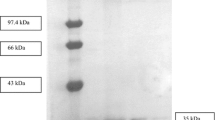Abstract
Lyophilization with salts has been identified as an important method of activating enzymes in organic media. Using salt-activated enzymes to transform molecules tethered to solid surfaces in organic phase requires solubilization of enzymes in the solvents. Methods of improving performance of salt-lyophilized enzymes, further, via chemical modification, and use of surfactants and surfactants to create fine emulsions prior to lyophilization are investigated. The reaction system used is transesterification of N-acetyl phenylalanine ethyl ester with methanol or propanol. Initial rate of formation of amino acid esters by subtilisin Carlsberg (SC) was studied and found to increase two to sevenfold by either chemical modification or addition of surfactants in certain solvents, relative to the salt (only)-lyophilized enzyme. The method to prepare highly dispersed enzymes in a salt-surfactant milieu also improved activity by two to threefold. To test the effect of chemical modification on derivatization of drug molecules, acylation of bergenin was investigated using chemically modified SC.
Similar content being viewed by others
References
Altreuter, D. H., & Clark, D. S. (1999). Current Opinion in Biotechnology, 10, 130–136.
Michels, P. C., Khmelnitsky, Y. L., Dordick, J. S., & Clark, D. S. (1998). Trends in Biotechnology, 16, 210–215.
Rich, J. O., Michels, P. C., & Khmelnitsky, Y. L. (2002). Current Opinion in Chemical Biology, 6, 161–167.
Dordick, J. S. (1992). Biotechnology Progress, 8, 259–267.
Adamczak, M., & Krishna, S. H. (2004). Food Technology and Biotechnology, 42, 251–264.
Gupta, M. N., & Roy, I. (2004). European Journal of Biochemistry, 271, 2575–2583.
Lee, M. Y., & Dordick, J. S. (2002). Current Opinion in Biotechnology, 13, 376–384.
D’Souza, S. F. (1999). Current Science, 77, 69–79.
Dai, L. Z., & Klibanov, A. M. (1999). Proceedings of the National Academy of Sciences of the United States of America, 96, 9475–9478.
Morgan, J. A., & Clark, D. S. (2004). Biotechnology and Bioengineering, 85, 456–459.
Sawae, H., Sakoguchi, A., Nakashio, F., & Goto, M. (2002). Journal of Chemical Engineering of Japan, 35, 677–680.
Song, B. D., Ding, H., Wu, J. C., Hayashi, Y., Talukder, M., & Wang, S. C. (2003). Chinese Journal of Chemical Engineering, 11, 601–603.
Mine, Y., Fukunaga, K., Yoshimoto, M., Nakao, K., & Sugimura, Y. (2001). Journal of Bioscience and Bioengineering, 92, 539–543.
Wang, L. F., Zhu, G. Y., Wang, P., & Newby, B. M. Z. (2005). Biotechnology Progress, 21, 1321–1328.
Hudson, E. P., Eppler, R. K., & Clark, D. S. (2005). Current Opinion in Biotechnology, 16, 637–643.
Altreuter, D. H., Dordick, J. S., & Clark, D. S. (2003). Biotechnology and Bioengineering, 81, 809–817.
Prior, R. L., & Cao, G. (1999). Proceedings of the Society for Experimental Biology and Medicine, 220, 255–261.
Mozhaev, V. V., Budde, C. L., Rich, J. O., Usyatinsky, A. Y., Michels, P. C., Khmelnitsky, Y. L., et al. (1998). Tetrahedron, 54, 3971–3982.
Bindhu, L. V., & Abraham, T. E. (2003). Biochemical Engineering Journal, 15, 47–57.
Kwon, O. H., Imanishi, Y., & Ito, Y. (1999). Biotechnology and Bioengineering, 66, 265–270.
Paradkar, V. M., & Dordick, J. S. (1994). Biotechnology and Bioengineering, 43, 529–540.
Clark, D. S. (2004). Philosophical Transactions of the Royal Society of London Series B, Biological Sciences, 359, 1299–1307.
Ru, M. T., Wu, K. C., Lindsay, J. P., Dordick, J. S., Reimer, J. A., & Clark, D. S. (2001). Biotechnology and Bioengineering, 75, 187–196.
Acknowledgements
The authors wish to acknowledge support from the National Institute of Health under the Bioengineering Research Partnerships. Initial project direction and assistance from Dr. Jonathan Dordick is greatly appreciated.
Author information
Authors and Affiliations
Corresponding author
Additional information
The submitted manuscript has been authored by a contractor of the US Government under contract No. DE-AC05-00OR22725. Accordingly, the US Government retains a nonexclusive, royalty-free license to publish or reproduce the published form of this contribution, or allow others to do so, for US Government purposes.
Rights and permissions
About this article
Cite this article
Borole, A.P., Davison, B.H. Improving Activity of Salt-Lyophilized Enzymes in Organic Media. Appl Biochem Biotechnol 146, 215–222 (2008). https://doi.org/10.1007/s12010-007-8033-y
Received:
Accepted:
Published:
Issue Date:
DOI: https://doi.org/10.1007/s12010-007-8033-y




